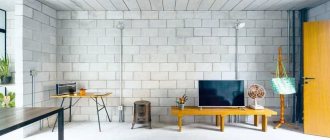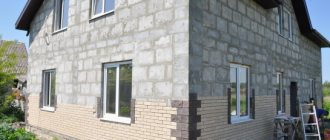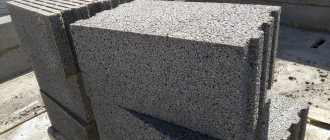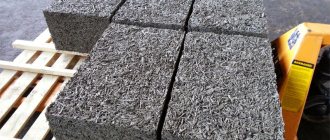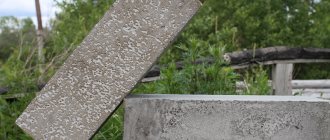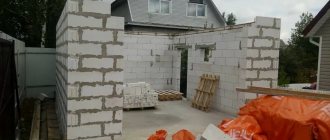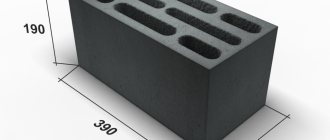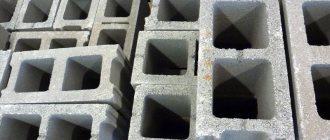Gas silicate products are used in the construction industry. The block production process is carried out under high pressure, as well as under natural conditions. Thanks to their porous structure, they retain heat well. The D500 gas silicate block is popular, the characteristics of which make it possible to use this material in the construction of houses. As a result of the use of blocks of increased sizes, the building construction cycle is shortened. Let's look at the main technical characteristics that need to be taken into account when choosing a material.
What are gas silicate blocks?
Gas silicate block products are a modern building material made from the following raw materials:
- Portland cement, which is a binding ingredient;
- quartz sand introduced into the composition as a filler;
- lime involved in the gas formation reaction;
- powdered aluminum added to foam the mass.
When mixing the components, the working mixture increases in volume as a result of an actively occurring chemical reaction.
Gas silicate blocks are widely used in the construction industry
Molding containers filled with silicate mixture harden under various conditions:
- naturally at ambient temperature. The hardening process lasts 15-30 days. The resulting products are characterized by a reduced cost, but have insufficiently high strength;
- in autoclaves, where products are heated at high pressure. Steaming allows you to increase the strength characteristics and specific gravity of gas silicate products.
Density and strength indicators change depending on the manufacturing method. The specified characteristics of the materials determine the area of use.
Blocks are divided into the following types:
- products for structural purposes. They are marked D700 and are in demand for the construction of permanent walls, the height of which is no more than three floors;
- thermal insulation and structural products. Brand D500 corresponds to these blocks. They are used for the construction of internal partitions and the construction of load-bearing walls of small buildings;
- thermal insulation products. They are characterized by increased porosity and density reduced to D400. This allows the use of gas silicate material for reliable thermal insulation of walls.
The digital index in the block markings corresponds to the mass of one cubic meter of gas silicate, indicated in kilograms. As the density of the material increases, its thermal insulation properties decrease. Products of the D700 brand are gradually replacing traditional brick, and products with a density of D400 are not inferior in thermal insulation properties to modern insulation materials.
Gas silicate blocks are superior in mechanical strength to foam concrete
What to look for when purchasing?
Before purchasing gas silicate material, you need to decide what they will be used for. If these are load-bearing walls, especially in multi-storey buildings, then you need a material with a density higher than D500.
For the construction of non-load-bearing walls and as wall insulation, elements with a density higher than D300 are suitable.
When choosing a material among products of the same price category, it is worth remembering:
- For load-bearing structures it is better to purchase more expensive material. This way there is a greater chance that the gas silicate will be of high quality and durable.
- For interior walls, partitions or non-essential structures (outdoor shower, bathroom, garage, bathhouse), you can purchase cheaper material.
Gas silicate blocks - pros and cons of the material
Products made from gas silicate have a complex of serious advantages. The main advantages of gas silicate blocks:
- reduced mass with increased volumes. The density of gas silicate material is 3 times less compared to brick and about 5 times lower when compared to concrete;
- increased safety margin to withstand compressive loads. The strength indicator for a gas silicate block marked D500 is 0.04 t/cm³;
- increased thermal insulation properties. The material successfully competes with annealed brick, the thermal conductivity of which is three times higher than that of gas silicate;
- correct shape of blocks. Thanks to reduced tolerances on overall dimensions and clear geometry, the blocks are laid on a thin layer of adhesive mortar;
- increased dimensions. The use of large-sized silicate blocks with low weight for the construction of building walls allows to reduce the duration of construction;
- good workability. If necessary, it is easy to give the gas silicate block a given shape or cut the block material into separate pieces;
- acceptable price. Using block gas silicate for the construction of a cottage, private house or cottage, it is easy to significantly reduce the estimated cost of construction activities;
- fire safety. The blocks do not ignite when heated or exposed to open fire. They belong to low-flammable building materials included in the G1 flammability group;
- high sound insulation properties. They are provided due to the porous structure. The ability of blocks to absorb external noise is ten times greater than that of ceramic bricks;
- environmental friendliness. In the production of the gas silicate mixture, no toxic ingredients are used and no components harmful to health are released during operation;
- vapor permeability. Through the air cells located inside the gas silicate mass, air exchange occurs, creating a favorable microclimate inside the building;
- frost resistance. Gas silicate blocks retain the structure of the massif and operational characteristics, withstanding more than two hundred cycles of prolonged freezing followed by thawing;
- heat storage properties. Gas silicate blocks are an energy-saving material that can accumulate thermal energy and gradually release it to increase the room temperature.
The scope of application depends on the density of the material
. Despite many advantages, gas silicate blocks have weaknesses. The main disadvantages of the material:
- increased hygroscopicity. Porous gas silicate blocks gradually absorb moisture through an unprotected surface, which destroys the structure and reduces strength;
- the need to use special fasteners for fixing hanging furniture and equipment. Standard fasteners do not provide reliable fixation due to the cellular structure of the blocks;
- insufficiently high mechanical strength. Block material crumbles under load, so it requires careful handling during transportation and laying;
- the formation of mold and the development of fungal colonies inside and on the surface of the blocks. Due to increased moisture absorption, favorable conditions are created for the growth of microorganisms;
- increased shrinkage amount. In real operating conditions, under the influence of loads, the blocks gradually shrink, which after some time causes the formation of cracks;
- reduced adhesion with sand-cement plasters. It is necessary to use special finishing compounds for plastering gas silicate.
Despite the existing disadvantages, gas silicate blocks are actively used for the construction of capital walls in the field of low-rise construction, as well as for the construction of thermally insulated walls of multi-story buildings and for thermal insulation of various structures. Professional builders and private developers prefer gas silicate blocks due to the significant advantages of the material.
Advantages of aerated concrete
The building material has become widely used due to the low weight of the erected walls, which greatly simplifies construction and does not require additional costs during the construction of the foundation and a large team of builders.
- Fire safety of buildings. The material does not burn because it includes completely mineral components.
- It is easily processed by all types of cutting and drilling tools; it can be given any shape and size without changing its physical and chemical properties.
- Environmentally friendly for people and the environment. Its radioactivity is several orders of magnitude lower than ordinary concrete due to the absence of gravel and crushed stone fillers, which have a high rate of natural radiation. Does not release hazardous chemical compounds into the air.
- We are breathable, there is an exchange of air between the room and the environment, it “breathes”.
- Durable, does not rot, and fungi and mold do not grow on its surface.
- Due to its low weight, it does not require special equipment for erecting the structure and delivering it to the work site. The lightness of the material reduces the load on the foundation, this allows you to select the type of foundation with minimal investment and reduce construction time.
- For masonry, glue based on Portland cement is used with the addition of modifiers and plasticizers. The masonry seam should not exceed 3 mm. This reduces heat loss in winter, because the cement joint has a size of up to 12 mm and it is through it that heat loss occurs during the cold season.
- Energy prices are constantly rising. Due to low thermal conductivity, it is easy to maintain a comfortable room temperature.
Gas silicate block D500 - characteristics of the building material
The structural and thermal insulation block of the D500 brand is used for various purposes:
- construction of boxes of low-rise buildings;
- arrangement of interior partitions;
- strengthening door and window openings.
Gas silicate blocks provide good thermal insulation of the room
Having decided to purchase block silicate marked D500, you should familiarize yourself in detail with the performance properties of the popular building material. Let's look at the main characteristics.
Strength properties
The compressive strength class of the material varies depending on the method of manufacturing the blocks:
- gas silicate grade D500, produced by the autoclave method, is characterized by a strength index of B2.5-B3;
- The compressive strength class for similar blocks produced using non-autoclave technology is B1.5.
The strength of D500 blocks reaches 4 MPa, which is not high enough. To prevent cracking of the gas silicate material, the masonry is reinforced with mesh or reinforcement. The relatively low safety margin allows the use of block building materials in low-rise construction. When constructing multi-storey buildings, gas silicate blocks are used together with bricks for thermal insulation of the walls being built.
Specific gravity
The density of gas silicate blocks is an important performance indicator that characterizes the porosity of the block mass. Density is indicated by markings in the form of the Latin letter D and a digital index. The number in the marking characterizes the mass of one cubic meter of gas silicate. Thus, one cubic meter of gas silicate marked D500 weighs 500 kg. Knowing the marking of products by density, the size of the blocks and their number, it is easy to calculate the load on the foundation.
Gas silicate blocks - environmentally friendly material
Thermal conductivity characteristics
The thermal conductivity of gas silicate blocks is the ability to transfer thermal energy. The value of the indicator characterizes the thermal conductivity coefficient of gas silicate blocks.
The value of the coefficient varies depending on the moisture concentration in the material:
- the thermal conductivity coefficient of dry gas silicate material grade D500 is 0.12 W/m⁰С;
- with an increase in humidity to 5%, the thermal conductivity of D500 blocks increases to 0.47 W/m⁰С.
In buildings built from gas silicate blocks, due to the reduced thermal conductivity of the material, a favorable microclimate is maintained year-round.
Frost resistance
The ability of gas silicate blocks to withstand temperature changes associated with deep freezing and thawing is characterized by markings. The frost resistance index for D500 products is F50. Compared to other types of composite concrete, this is a pretty good indicator. Frost resistance is affected by the moisture concentration in the blocks. As the moisture content of the material decreases, the frost resistance of the blocks increases.
Lifetime
Gas silicate has a long period of use. The structure of the gas silicate massif has maintained its integrity for more than half a century. Manufacturers of blocks guarantee a service life of products for 60-80 years, provided that the blocks are protected from moisture absorption. Plastering the material allows you to extend its service life.
Fire safety
Gas silicate blocks are a fireproof building material with fire resistance up to 400 ⁰C. Tests confirm that a gas silicate wall coated with plaster can withstand exposure to open fire for three to four hours. The blocks are suitable for the construction of fire-resistant walls, partitions and chimneys.
Production and sale of gas silicate in Russia
- In the capital region, a significant share of the market for this material is occupied by, with a wide dealer network in the central region, which includes Moscow and the Moscow region, Tula, Kaluga, Ryazan, Orel. Therefore, for example, if the sphere of commercial interests is Ryazan, the price of gas silicate will be the same as in Moscow, that is, from the manufacturer.
- Another Moscow company offers gas silicate blocks “EL-BLOCK” and “EuroBlock”, the production of which is located in Klintsy (Bryansk region). The buyer is provided with loyal terms of purchase, as well as delivery: by company transport or self-pickup.
- Cooperation with this company is beneficial for construction companies operating in the cities of Kirov, Nizhny Novgorod, Lipetsk. Prof-Beton LLC also provides loyal conditions to its customers, presenting products on the market under the trademarks Bikton, GRAS, Aerostone and El Block.
- represents the products of EuroBlock and the Yegoryevsk Plant (EZSM) on the market. presents gas silicate blocks Bonolit (St. Kupavna), Masa Henke (Mogilev), EuroBlock (Klintsy). Thanks to its extensive logistics structure, it can deliver not only to the central region, but also to Stavropol, Kaliningrad and even to Minsk (Belarus).
- It should be noted that in large cities of Russia there is also local production of gas silicate blocks, but their capacities cannot always satisfy all the needs of the population and construction organizations for this product. In addition, in some cases, import from other regions is justified. But even in this case, taking into account the increase in price due to transportation, it is profitable to build from gas silicate blocks.

